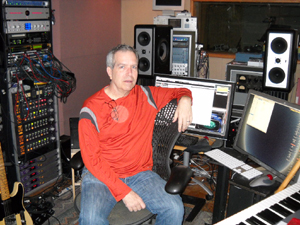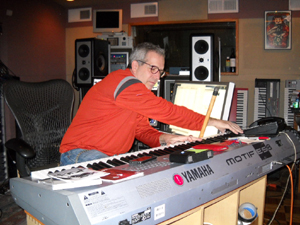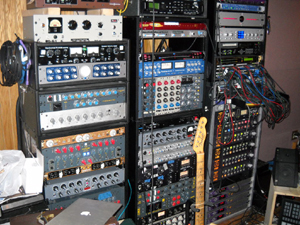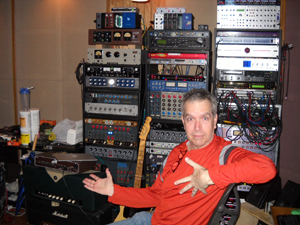Music Producer Profile: David Kahne Leads On
HELL’S KITCHEN, MANHATTAN: Modern music can get shaped by the most unassuming of influencers. David Kahne is one such source: often unseen, but always very well heard.
Spend some time with him, and it’s clear that he always puts sound first. If you’re lucky, you’ll be there when Kahne hears a song that he loves – wholly absorbed, the music literally moves him.
After being an artist on Capitol Records a long time ago, in a galaxy far far away, Kahne stayed interested in the studio. He became a producer/engineer for the legendary 415 Records new wave label in San Francisco, then a VP of A&R for Columbia Records and Warner Bros.
Along the way, Kahne’s scientific instincts established him in some circles as an indispensable producer. In addition to a GRAMMY win for producing Tony Bennett’s 1995 MTV: Unplugged album, Kahne’s production credits range from Fishbone, Sublime, Sir Paul McCartney, The Strokes, Sean Lennon, and Linkin Park, to current collaborators such as Ingrid Michaelson, Regina Spektor, James McCartney, Jay Brannan, and The Dirty Pearls. If that’s not enough, Kahne is beginning a production of a ballet version of Peter Pan that he wrote, and he’s just wrapped scores on three films.
One way he does it is by working out of a personal audio wonderland he’s established at Avatar Studios. A resident of New York City since 1990, and bi-coastal until 4 years ago, Kahne was led from the Golden State by his muses to become a full-time NYC dweller. Now Kahne is feeding off of the Big Apple’s energy as he moves music forward.
Why is NYC your home base now? And how did you settle on Avatar as your HQ?
I liked the vibe and the creative feeling of it here. I’ll give you a great example; I write ballet music — I recently wrote a ballet of Peter Pan in MIDI – and I found a choreographer in Brooklyn. 90 dance companies use her space, and it’s part of a thing that makes that sense of DIY seem stronger here.
I sometimes feel like the LA scene is more about chasing the industry – although there are so many talented musicians there – and I like the environment of NYC. Walking, biking, the way the clubs are…It’s more saturated here in the city.
How does that translate with the artists you’re working with here in NYC?
When I was head of A&R at Columbia, there were 212 artists on the roster. I asked somebody over there recently how many artists they currently have signed onto the roster, and they said it was in the fifties. So that’s a hundred-something records not being made, artists not being supported. Those artists are still making music, but now they’re trying to turn their own thing.
People I work with like Regina Spektor, Ingrid Michaelson, Jay Brannan, these are amazing artists — Jay books himself, he manages himself, and he saves money for his album budget. It’s hard. You’re spending more and more time promoting yourself, and less time making music. But I think that that’s the way it’s going to be for more and more artists.
Back in the day, there was a general feeling that a song could change the world. And that created an environment for big rosters and lots of sales, and more artists being able to have careers spanning decades. I think that bubble has burst.
I feel like we’re all entrepreneurs now, more than ever. The means of distribution and collection change almost faster than we can adapt to them, and there’s not a settled system for monetizing the music. So it’s harder to build a business.
I also think it’s interesting that we’re back to the way it was in the ‘50’s, a singles market. The publishers started record companies then, and they have a lead on the power now, especially when you talk about the synch fees. Synch seems like the new radio for lots of new artists.
It’s very difficult for a major label to build up an artist around touring. It takes a long time to do that, and for the most part, I don’t think the numbers work. Gotta get radio.
A self-contained artist would most often have a very hard time with all the test marketing that goes on, and all the changes that are made to the music to meet the market expectation. If the market were “people who are looking for something new, different, etc…” it would be a different music world. But that market is very individualized, and spread out and you have to reach it in a different way. That’s my opinion, anyway.
Shifting gears, how do you see yourself today? As a producer? Mixer? Engineer? Composer? All of the above? How do you balance all those roles?
Yes, all of the above. Because of the economics of things now, I’m mixing. I think my favorite parts of the process — arranging and programming — are sort of blended together, and that’s one reason I like working on the ballet so much. It’s all orchestral, and when you’re scoring something you’re actually mixing something while you’re writing the arrangement.
With my MADI system in my room here at Avatar, I mix as I go. I have all this outboard gear and it’s all accessible through real time via the MADI. When I call Cubase up to continue a session or do an overdub, I call all my hardware up at the same moment.
I have the entire Vienna library on one dedicated computer. It runs through Ethernet with zero latency – it’s mind-blowing. I used to be able to load four complex instruments on Cubase, now with this 64-bit computer running Windows 7 I can load 31! Another computer runs only Hollywood Strings, which is a fantastic library, but it’s all solid state drives. Some of these Hollywood Strings loads are 18,000 samples and streaming. Without solid state drives, you can’t even load the complex instruments. It’s worth getting the drives.
It’s crazy, but it’s fascinating technology. Again, with the DIY thing, you’re getting to the place where you’re going to have the ability to create whole orchestrations, to the point where nobody’s going to be able to tell it’s not a real symphony orchestra playing.
Looking at your setup and how many up-to-date components you have – hardware and virtual – it’s clear that you’re constantly introducing new software and hardware into your system. How do you keep up such a breakneck pace?
Every time I see a new plugin, I buy it! I bought buy plug-ins like Geist or Trigger the first day they come out. I’m quite the early adopter. I went full 64bit and Windows 7 the moment it was possible. I’m spending probably 15% of my time keeping my gear running and checking out new software.
I don’t need any new hardware. Sometimes I think about having a console, and then I tell myself I’m insane, what am I talking about? I have friends that are still on consoles, and they sometimes feel behind the curve, because it takes time to get up to speed on the computer, and trust your software.
Hardware compressors are my favorite thing. I’ve got a Fairchild, and two Federals over there. Someone told me about the Elysia Mpressor when it came out, and I freaked when I got it. It’s so powerful – with the gain control, you can get tremendous compression without harshness. You can get it to pump and suck, and now the software version is identical to the hardware unit, as far as I can tell.
But Brainworx and all the UAD stuff, and some of the SPL stuff is important stuff to have because it’s like having another instrument. It’s like the difference between two different kinds of saxophones. You’d use one for one thing, and a different one for another.
How does your particular studio setup allow you to get around the console?
I have four Dangerous 2-Bus summing boxes, totaling 64-channels, with my analog outboard gear hard-wired between the interface D/A outputs and the inputs to the 2-Busses. This allows me to select what track or stem I want to send to a particular piece of outboard via the output assignment in MADI, so I have in effect a virtual analog patch bay.
You can also set up parallel processing chains with this system. For example, I have an output from the computer going to my Fairchild on a dedicated line, so I can send a dry stem directly to the Dangerous 2-Bus and also send the same stem to the Fairchild; the Fairchild is patched into its own 2-Bus input, so I get foldback compression as part of the stream in the 2-Bus summed mix. If I want insert compression only, I just turn off the dry stem feed. All the audio splits out in the MADI mixer, 64 tracks.
I save the MADI mixer doc for the song I’m working on, and when I call the song back up in the DAW, I load the MADI mixer and my mix is back exactly as I left it. I have about 20 pieces of gear, or chains of gear, that I can access from my computer in this way.
You get the call for some pretty high-profile clients to work on their projects – Sir Paul McCartney picking you to co-produce James McCartney’s excellent 2010 EP Available Light comes to mind. Why do you think they chose you?
I’ve been working with Paul for a while, on two studio albums and three live albums. I’d met James earlier, and we all knew each other, and Paul asked me if I would work on James’ album with him. Paul knows me and I think he thought I’d be a good person to get the album done. And we’re still working on it. We just did two new songs – it’s a work in progress.
You seem to really get the most out of a band’s sound, whether you’re working with James McCartney, Fishbone, The Strokes, Regina Spektor. What’s your approach to tracking and mixing?
Mostly it’s the preparatory work, I have to say, that I really like. I spend a lot of time in rehearsal and pre pro, so that as much as I can know about not only the amplifier, but how the people play. That’s if it’s a band. If it’s a solo artist, I like to build models and get the vocals done as soon as possible, and then do the arrangements: and record the live instruments last. Takes the mystery out of it, saves money, and there’s still plenty of room for surprises to happen with great players.
You know, I was in Vegas once. I was backstage, there were these tall girls walking by with massive eyelashes — they looked like freaks. I thought, “It’s so weird looking.” But later on, seeing them out in the theater they looked really pretty. It’s about scale. Environment. Arranging and mixing for stereo is the same thing – you’re trying to create depth and power using musical tools of counterpoint, voice-leading. Then software after. At least, that’s what I try to do.
My main focus for arranging is vocals. For example, there’s a band I was going to work with, where this girl is an amazing singer. There was all this great stuff I heard from them live, but the demos of the new songs had big holes. In a lot of the songwriting, they’d have a verse that worked great. You could feel this stuff going on between the quiet and loud in her voice, and you knew that was going to work. But in the pre-choruses, she would start vamping because there wasn’t enough information there, and as a singer she instinctively knew there wasn’t enough going on in the song — she was trying to make it happen physically in the performance, rather than in the composition.
So she was giving away the nut that was supposed to be in the chorus. I heard her go there in a less musical way. She was solving the problem by singing it out. She felt like she made the arc to the chorus, but I was talking to her about working on this one part of the song so that she could sing across the bar line and get into the chorus.
That would have solved the problem, but the leader of the band didn’t like that. I didn’t end up working on the project. I like to find that out early on – if I can’t develop an approach to the music overall with the artist, it’s best that we don’t work together. There’s only been a few times when I’ve started working and the method we’d agreed on didn’t work.
An emerging NYC band you’re working on now is the Dirty Pearls. How did you get involved with them?
I heard their song “New York City Is a Drug”, and I really liked that. So we worked together on the album. I really liked the style of that record – they wanted to play guitars loud and be a band. I saw these guys live at a music festival. There were 20 bands on before them that were completely interchangeable. Then these guys came on – they have a show, they look different.
We’re trying to see if we can get something going with them. We’re getting airplay, but again as we were talking about earlier, it’s some guys starting a business. They’re building their brand, so to speak – that term is used so much now.
We’ve talked about you being a mentor and inspiration to many. Who out there is inspiring you now?
Bartok. I listen to Bartok’s Concerto for Orchestra to go (in awe) “FUUUUCK!”. To feel tiny. There’s a bust of him on 57th because he used to live over there. I go by there to look at his head.
Regina Spektor was a big influence on me. She’s one of the reasons I moved back here, because she’s completely her own person. That’s how Brad in Sublime was, and he was a big influence on me as I was working with him, not before. I end up being very heavily influenced by the people I work with if they’re really good: Paul, Regina, Brad, James Brown… Fishbone was a huge influence on me. I go back and listen to that stuff, and think about all the different places they were coming from.
When I was in college, I was listening to Count Basie and I decided I would try to do that. So I got theory books, studied them like a music slave, and wrote with my first big band chart. It’s all about that organization of instruments and tones in time. What do you play and where does it go? You look at a score, and you have a master plan for the musicians. Then they play it, you listen, and then say (awed), “Oh FUCK. I suck,” or “I’m doing OK.”
That’s why the masters were so influential to me – I learned by reading their scores. It’s just some guys doing great stuff, and it’s fascinating to see how they approached it – and did it a hundred years before it became popular. Debussy, they must have thought he was out of his fucking mind, like the Dead Kennedys.
That kind of thinking about music is sort of what I assume you could keep yourself sane with. Because you’re in awe of something, it gives you perspective. Rather than thinking that brushing your teeth with Jack is the coolest thing you could possibly do.
— David Weiss
Please note: When you buy products through links on this page, we may earn an affiliate commission.












Rosemary Neece
August 29, 2011 at 9:42 pm (13 years ago)I remember seeing David’s set up in his apt. kitchen in LA in the late 1980’s. What a talented and amazingly gifted man. Great to see him and read about his accomplishments. I was impressed with him when he used to play his guitar for me in El Paso, Texas,1966. Congratulations to a career well lived. Rosemary Neece, Mill Creek, WA
Michael Campbell
August 24, 2015 at 2:47 am (9 years ago)I remember David Kahne from the 70’s , Sacramento, Ca. His ability to bring music to life and make you enjoy playing impressed me. Yes, Mister Kahne, I finally figured it out. You were always on me telling me to learn my notes, instead of just being able to play the bass by ear. And I still like playing ‘Scorpio’ by Dennis Coffey….you’re the best!!
My best to you,
Michael Campbell